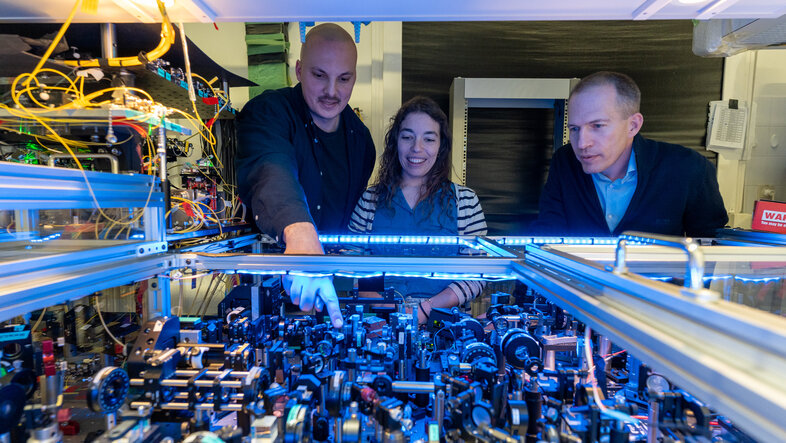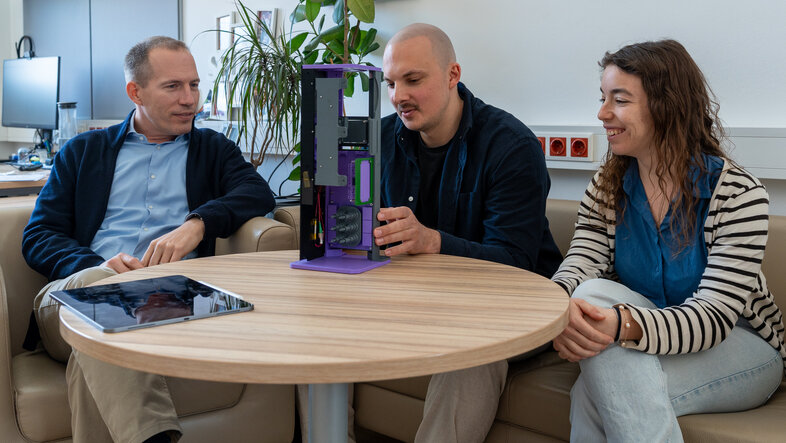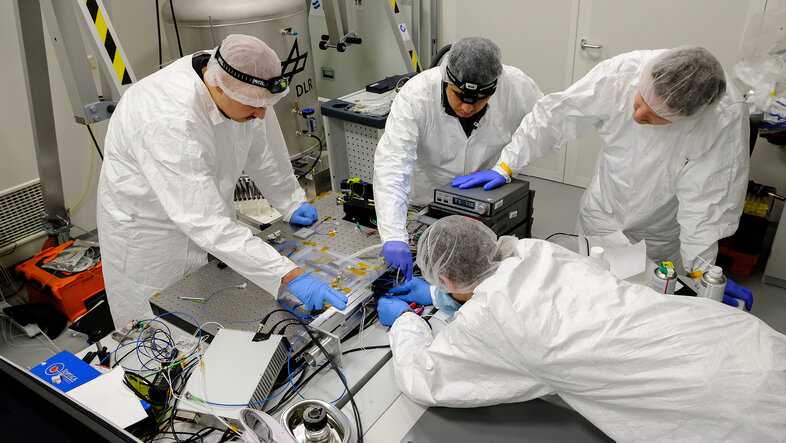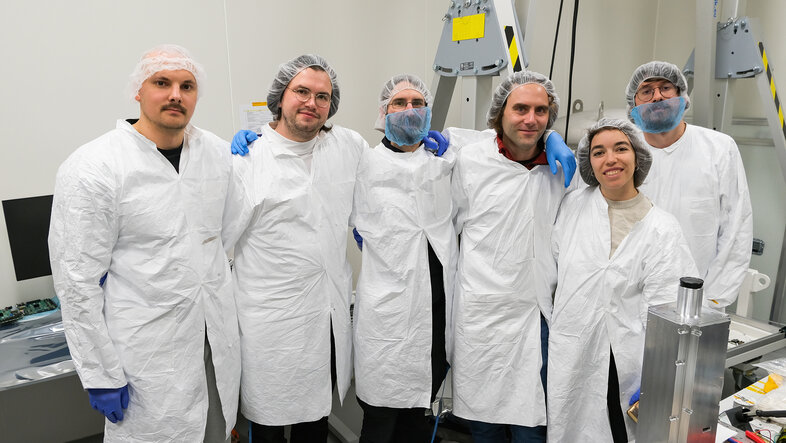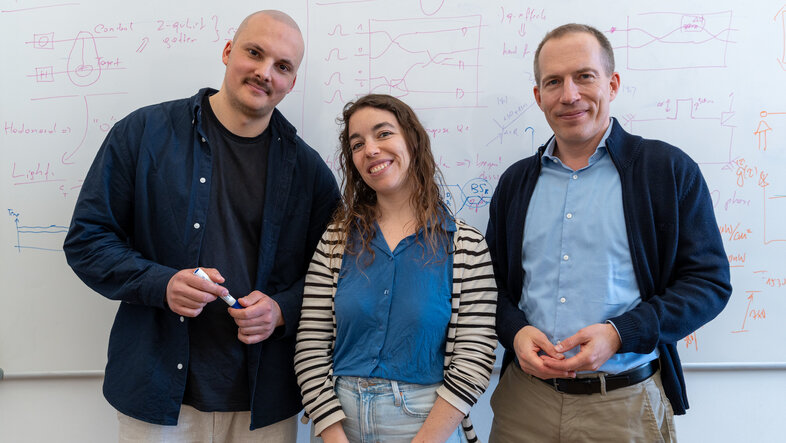How to build a quantum computer in eleven days
In the evening, somewhere in a small German town, Peter Schiansky and Simon Steiner have a deadline breathing down their necks. They urgently need to produce a component with a 3D printer by the next day. They did bring the printer with them from Vienna, only to leave the power cable—an ordinary household cable—behind at home. Necessity, however, proves yet again to be the mother of invention. The two young quantum researchers rushed to scour a nearby Lidl supermarket just before closing time, discreetly prying open the packaging of microwaves and other appliances. At the end, they bought a toaster—an unassuming hero that ultimately helped produce what will be the first quantum computer in space.
At the beginning of 2025, a 12-person research team from the University of Vienna spent a total of four weeks in a special "clean room" at the DLR Responsive Space Cluster Competence Center in Trauen (Germany). Virtually cut off from the outside world, the young quantum researchers have only one goal in mind: to build the world's first functioning mini quantum computer at record speed, so that it can be launched into space in June 2025 to deliver Earth observation data.
"The working atmosphere was extremely tense—we only had eleven working days to build the flight model from scratch," recall postdoctoral researcher Iris Agresti and PhD candidate Simon Steiner. Four months later, the two of them are sitting in the office of team leader Philip Walther in Boltzmanngasse. Now relaxed, they are eager to talk. A 3D model of the miniature quantum computer rests on the coffee table in front of us.
"Our time slot in the clean room began on 14 January," one of them explains. "The airworthy payload, to be installed in the satellite and then undergo integration tests, had to arrive at the partner company in Italy by 27 January at the latest." This tight deadline had no margin for errors. "The laying of a highly sensitive fibre optic cable was particularly tricky. One wrong bend, one careless touch, and we would have lost two full working days," recalls Steiner with a shutter.
Small satellite launch lexicon
- Satellite payload: The part of the satellite that carries out the primary function of the satellite’s mission, e.g. measuring instruments, cameras or communication systems. It carries out the actual tasks of the satellite in space.
- Flight model: The final, operational version of the satellite, which is intended for launch and operation in space. It is prepared for the space mission after extensive testing.
- Engineering model: A prototype of the satellite that is mainly developed for testing and validation. It is used to test functionality and solve technical challenges before the flight model is built.
- Clean room: A specially air-conditioned room in which satellites and their components are assembled and tested to protect them from dust and contaminants that could damage the technology.
- Integration test: Check whether various system components, such as the payload and the satellite, work together smoothly.
A pocket-sized lab: the mini quantum computer
How did it all begin? The hot phase in the clean room marked a critical milestone in an intensive project sparked by an idea in May 2023. There are more milestones to come— if weather permits and the technology holds up, the next major moment is the rocket launch. And then it'll be all eyes on the sky as we nervously wait to see whether the first quantum computer in space will function as planned, delivering data as expected. But since the very beginning, the team had weathered a roller coaster of challenges.
"It all started with the opportunity to take part in a potential space mission that offered us a free space on a satellite for a quantum experiment, a free flight into space, so to speak. However, there were strict time constraints: Everything had to be ready within a year. We decided to accept the challenge and try something completely new that went beyond existing quantum communication: Namely, we aimed to shrink a whole quantum laboratory down to the size of a satellite payload," says research group leader Philip Walther: "We had to learn everything ourselves from scratch, as we are not aerospace engineers. It was a classic case of learning by doing," adds Simon Steiner.
And the framework conditions also changed. "The mission was originally planned with a start-up company, which failed. We were therefore forced to switch to another satellite and adapt the payload," explains Iris Agresti. And then virtually at the last minute, the researchers secured the funding needed to push the project forward. Without a substantial third-party funding, none of these innovations would've happened.
Expertise for quantum research in space
In total, the team from the University of Vienna spent a year and a half working on the quantum computer. Initially, each team member worked independently on various components, such as the photon source, optical circuit and detectors.
All of these components had to be built from the ground up. "In the final phase, we had to bring everything together in a space of less than three litres: the mechanical framework, the optics, the electronics with the on-board computer including software and, in particular, the interface to the carrier satellite," says Agresti. "It was an intensive time, but also a valuable experience."
"Everyone contributed their expertise, and we had to learn to trust each other,” says Steiner, who adds, "The greatest success was that our quantum computer passed all the tests and is now ready for launch into space."
This project has turned us into a 'space group'. We now have the expertise to carry out further experiments in space, whether for fundamental quantum physics or practical applicationsPhilip Walther
High-tech teamwork in the clean room
During the four weeks in the clean room, the team created two models of the mini quantum computer: a flight model for use in space (completed in 11 days) and then an identical engineering model for tests on Earth. Each of these individual components had to be tested and optimised in this short stretch of time, installed in a compact housing, and then precisely matched to each other, drawing on expertise from the fields of quantum physics, space technology, electronics and software development.
The project team: Iris Agresti, Mathias Dragosits, Martin Mauser, Daniel Martinez, Raphael Pimenta, Simon Steiner, Zhenghao Yin (University of Vienna); Peter Schiansky (University of Vienna/Qubo Technology); Tobias Guggemos, Antonius Scherer (University of Vienna/DLR); Riccardo Albiero, Francesco Ceccarelli (Istituto di Fotonica e Nanotecnologie, Milano) und Niki di Giano (Politecnico di Milano)
Tip: As part of the panel discussion on the semester question on June 16 (in German), you can meet members of the project team and learn more about the mini quantum computer (in English)!
Small but mighty: quantum computer powers edge computing
So what are the benefits of a quantum computer in space? The big advantage is that it enables 'edge computing'. This means that the data are processed directly on the satellite. This saves time and energy, as the data do not need to be transmitted via communication channels. Instead, the satellite delivers the results of the analysis, e.g. the detection of a forest fire, directly.
Additionally, quantum computers are more energy efficient. Using optical systems, mathematical operations can be performed by exploiting the physics of interference and diffraction. This analogue approach is far more efficient for processes that are computationally intensive on classical computers, such as Fourier transforms or convolutions.
Most excitingly, the system developed by the Viennese quantum physicists is versatile: It can be customised for future missions. "This mission also enables us to test the performance and robustness of quantum hardware in extreme conditions. We can investigate how long it remains functional in the harsh environment of space," explains Philip Walther.
We work with photons, the particles of light, because they are ideal for quantum applications. They are fast, hardly interact with the environment and enable precise information processing.Iris Agresti
Learn more about the research of the "Walther Group"
Philip Walther and his team at the University of Vienna are pioneers in developing photonic quantum technologies for quantum computers. They combine this work with research into fundamental quantum phenomena, in keeping with the University's long tradition of quantum research. This ranges from the control of individual light particles to research into gravitational forces. This puts the quantum physicists at the University of Vienna at the forefront of the global race for the next generation of quantum technologies.
- Find more "Quantum knowledge" in our YouTube playlist on the semester question!
Philip Walther can hardly contain the pride he has for the dedicated, creative team's achievement in developing the world's first photon-based, space-proof quantum computer. "There was an incredible dedication in this team. We stood up and said: 'We have the chance to be the first in the world with this project, many years ahead of other countries'," says Walther. The result is a fully functional system that can quite literally be thrown from the fifth floor. "This shows that even smaller research teams are capable of achieving ambitious and novel results without necessarily having to scale up to very large platforms, as large international players such as IBM or Google do."
This project strengthens Europe's and Austria's pioneering status in quantum research.Philip Walther
Profile of the mini quantum computer
- Size: 150x150x453 mm
- Weight: approx. 9.5 kg
- Material: Aluminium frame, optical circuit made of borosilicate glass, carbon fibre frame for the single-photon source, titanium mounts for sensitive components, optical glass fibres, optical lenses, focusing lenses, lots of glue (!)
- Energy consumption: less than 30 W
- Functions: The quantum computer can record images of the Earth and perform transformations on single photons. This enables experiments in the field of machine learning and other planned experiments.
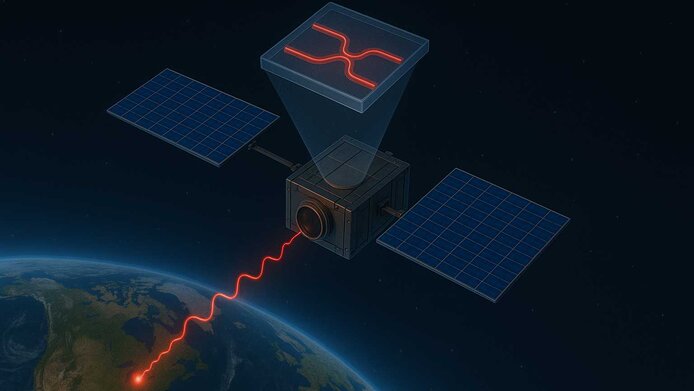
Quantum physics meets climate research
The space industry is growing rapidly and there is a great need for innovative technologies. Looking to the future, Walther states that "our findings can contribute to the further development of quantum hardware for commercial and scientific applications, for example in the fields of earth observation, climate research and communication." Investigating fundamental questions of quantum physics, such as the interaction between quantum entanglement and gravity, or the stability of quantum phenomena under cosmic radiation, is particularly exciting for basic research.
Mission accomplished
Until the satellite is actually launched, nerves are on edge. Right after, though, tension will run high again: It will be a week at the earliest before the first signals are expected. Only then can we be certain that the quantum computer is successfully running in space.
Whatever happens, the project is already a success for the team involving Iris Agresti and Simon Steiner. They have built a miniature quantum computer whose suitability for space has been officially confirmed—a technological masterpiece. They have demonstrated the potential of combining interdisciplinary expertise and teamwork, becoming space experts in the process.
Furthermore, the small quantum computer is not destined to become space debris. The satellite will burn up in the atmosphere in a controlled manner after completing its mission. Until then, it could provide data that will shape the future of quantum research. We at the Rudolphina will be looking to the stars together with the Viennese quantum physicists and will keep you up to date.
World's first quantum computer in space: Stay updated on its mission!
The world's first quantum computer in space has been successfully launched! On Monday night, June 23, the rocket carrying the mini quantum computer, developed by Philip Walther and his team, lifted off into space. And Communication with the satellite has been successfully established.
Check back here for updates on whether the quantum computer begins its mission in space as expected!
The project team would like to thank the WSM supervision team (David Kleemann, Hannes Brandt, David Freiknecht) from the RSC3 (Responsive Space Cluster Competence Centre) at the DLR Trauen site for their support and for providing the test infrastructure.
- YouTube playlist on the semester question
- Looking for more firsthand knowledge? Sign up for the Rudolphina newsletter
- Quantum Information Science and Quantum Computation research group
- Christian Doppler Laboratory for Photonic Quantum Computer
- German Aerospace Center
- DLR Responsive Space Cluster Competence Center
- Istituto di Fotonica e Nanotecnologie, Milan
- Politecnico di Milano
- CAE Simulation Solutions
